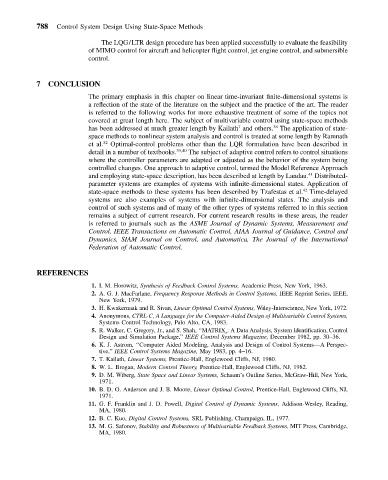Page 797 - Mechanical Engineers' Handbook (Volume 2)
P. 797
788 Control System Design Using State-Space Methods
The LQG/LTR design procedure has been applied successfully to evaluate the feasibility
of MIMO control for aircraft and helicopter flight control, jet engine control, and submersible
control.
7 CONCLUSION
The primary emphasis in this chapter on linear time-invariant finite-dimensional systems is
a reflection of the state of the literature on the subject and the practice of the art. The reader
is referred to the following works for more exhaustive treatment of some of the topics not
covered at great length here. The subject of multivariable control using state-space methods
38
7
has been addressed at much greater length by Kailath and others. The application of state-
space methods to nonlinear system analysis and control is treated at some length by Ramnath
et al. 32 Optimal-control problems other than the LQR formulation have been described in
detail in a number of textbooks. 39,40 The subject of adaptive control refers to control situations
where the controller parameters are adapted or adjusted as the behavior of the system being
controlled changes. One approach to adaptive control, termed the Model Reference Approach
and employing state-space description, has been described at length by Landau. Distributed-
41
parameter systems are examples of systems with infinite-dimensional states. Application of
42
state-space methods to these systems has been described by Tzafestas et al. Time-delayed
systems are also examples of systems with infinite-dimensional states. The analysis and
control of such systems and of many of the other types of systems referred to in this section
remains a subject of current research. For current research results in these areas, the reader
is referred to journals such as the ASME Journal of Dynamic Systems, Measurement and
Control, IEEE Transactions on Automatic Control, AIAA Journal of Guidance, Control and
Dynamics, SIAM Journal on Control, and Automatica, The Journal of the International
Federation of Automatic Control.
REFERENCES
1. I. M. Horowitz, Synthesis of Feedback Control Systems, Academic Press, New York, 1963.
2. A. G. J. MacFarlane, Frequency Response Methods in Control Systems, IEEE Reprint Series, IEEE,
New York, 1979.
3. H. Kwakernaak and R. Sivan, Linear Optimal Control Systems, Wiley-Interscience, New York, 1972.
4. Anonymous, CTRL-C, A Language for the Computer-Aided Design of Multivariable Control Systems,
Systems Control Technology, Palo Alto, CA, 1983.
5. R. Walker, C. Gregory, Jr., and S. Shah, ‘‘MATRIX x : A Data Analysis, System Identification, Control
Design and Simulation Package,’’ IEEE Control Systems Magazine, December 1982, pp. 30–36.
6. K. J. Astrom, ‘‘Computer Aided Modeling, Analysis and Design of Control Systems—A Perspec-
tive,’’ IEEE Control Systems Magazine, May 1983, pp. 4–16.
7. T. Kailath, Linear Systems, Prentice-Hall, Englewood Cliffs, NJ, 1980.
8. W. L. Brogan, Modern Control Theory, Prentice-Hall, Englewood Cliffs, NJ, 1982.
9. D. M. Wiberg, State Space and Linear Systems, Schaum’s Outline Series, McGraw-Hill, New York,
1971.
10. B. D. O. Anderson and J. B. Moore, Linear Optimal Control, Prentice-Hall, Englewood Cliffs, NJ,
1971.
11. G. F. Franklin and J. D. Powell, Digital Control of Dynamic Systems, Addison-Wesley, Reading,
MA, 1980.
12. B. C. Kuo, Digital Control Systems, SRL Publishing, Champaign, IL, 1977.
13. M. G. Safonov, Stability and Robustness of Multivariable Feedback Systems, MIT Press, Cambridge,
MA, 1980.

